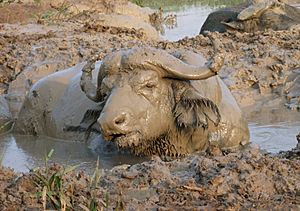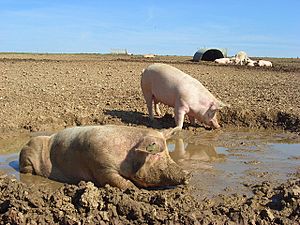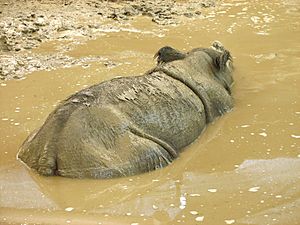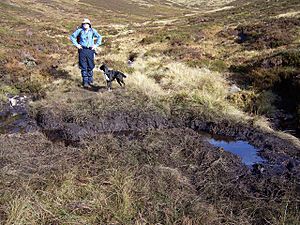Wallowing facts for kids
Wallowing is a special way animals relax and take care of themselves. It's when an animal rolls around or lies down in mud, water, or snow. Sometimes, animals also roll in dust, but that's usually called "dust bathing." Wallowing often helps animals do other things too. For example, elephants might throw dirt on themselves after a mud bath to make a thicker coat. Pigs might let the mud dry on them, then rub against a tree to scrape off tiny bugs stuck in the mud.
Contents
Why Animals Wallow
Animals wallow for many different reasons. Scientists have suggested several purposes, and some have been studied closely.
- Staying cool: Animals like pigs, rhinos, warthogs, and elephants use wallowing to cool down when it's hot.
- Sunscreen: Pigs, warthogs, and elephants can get a layer of mud that acts like sunscreen.
- Male animal challenges: Male elk, European bison, and deer sometimes wallow as part of showing off to other males.
- Getting rid of bugs: White rhinos, American bison, and warthogs wallow to remove tiny bugs that live on their skin.
- Being social: American bison might wallow together, which helps them feel more connected.
- Shedding skin or fur: European bison and elephant seals wallow to help with shedding their old skin or fur.
- Stopping biting insects: Animals like tamaraw, American bison, tapirs, warthogs, and elephants wallow to get relief from annoying biting insects.
- Playing: Young American bison sometimes wallow just for fun!
- Keeping skin healthy: Hippos wallow to keep their skin from drying out.
- Hiding: Warthogs can use mud to help them blend in with their surroundings.
- Leaving a scent: Some animals pee in a wallow before rolling in it. This might be a way to leave their scent for other animals to find.
- Skin health: Horses might wallow to help keep the tiny living things on their skin healthy.
Pigs and Their Mud Baths
Pigs don't have many working sweat glands and can't pant much to cool down. So, they rely on wallowing in water or mud to lower their body temperature. Adult pigs living freely often wallow when the air temperature goes above 20 degrees Celsius (68 degrees Fahrenheit). They prefer mud because it creates a cool, protective layer on their skin after they get out.
When pigs enter a wallow, they usually dig and root around in the mud first. Then, they go in headfirst. They wiggle their bodies back and forth and rub their faces in the mud until their whole body is covered. Before leaving, they often shake their heads and bodies. They might even rub against a tree or rock near the wallow. Even indoors, if it's hot, pigs will try to wallow on wet floors.
While staying cool seems to be the main reason pigs wallow, they will still do it even when it's colder. Some people think pigs wallow because they don't sweat much. But it's also possible that pigs and other wallowing animals didn't develop many sweat glands because wallowing was already a natural part of their behavior.
Pigs are related to animals like hippos and whales. Some scientists believe that wallowing behavior, and the desire to be in shallow, muddy water, might have been an early step in how whales and other sea mammals evolved from land animals.
Sumatran Rhinos and Their Wallows
The Sumatran rhino spends a lot of its day wallowing. If there are no mud holes, they will use their feet and horns to make puddles deeper. One study that watched rhinos for 20 months found that they usually use no more than three different wallows at a time. After using a wallow for two to 12 weeks, the rhino will move on to a new one.
Rhinos typically wallow around midday for two to three hours before they go looking for food. In zoos, Sumatran rhinos have been seen wallowing for less than 45 minutes a day. However, the study of wild rhinos found they spent 80 to 300 minutes (about 1.5 to 5 hours) each day in wallows. Rhinos in zoos that didn't have enough places to wallow quickly got skin problems, eye issues, and even died. This shows how important wallowing is for their health.
Deer and Their Wallowing Spots
Many types of deer wallow. They create wallow spots in wet, low areas on the ground. Over time, these spots can become quite large, sometimes 2 to 3 meters (6.5 to 10 feet) across and up to 1 meter (3 feet) deep.
However, not all deer species wallow. Red deer, for example, really enjoy wallowing. But fallow deer usually do not. Even within the red deer family, different types or breeds might wallow more or less. For instance, a type of red deer called wapiti do wallow, but they and mixed breeds are less likely to wallow than European red deer.
See also
- Personal grooming
- Mineral lick
Images for kids






